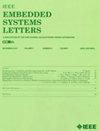Analysis of S-Box Hardware Resources to Improve AES Intrinsic Security Against Power Attacks
IF 2
4区 计算机科学
Q3 COMPUTER SCIENCE, HARDWARE & ARCHITECTURE
引用次数: 0
Abstract
Side-channel attacks (SCAs) have rendered Internet of Things (IoT)-based devices unsafe despite employing Advanced Encryption Standard (AES) as the cryptographic algorithm. Additional circuitry, called countermeasures, is used to protect AES against the attacks at the cost of huge area and power overheads. The attacks are performed on SubBytes round operation of AES, which comprises of 16 S-boxes. This letter makes a novel attempt to boost the intrinsic security of an unprotected AES by analyzing four smallest composite field arithmetic (CFA)-based S-boxes available in literature, Circuit Minimization Team (CMT), Canright, Maximov, and Masoleh with lookup table (LUT)-based S-box as a reference. This letter proposes an AES design which is unprotected but with enhanced security. The designer can aim higher security by adding smaller countermeasure protective schemes before incorporating into IoT devices. A novel 3-D hardware analysis, namely, hardware resources, hardware complexity/linearity, and hardware security, is performed which demonstrates that lesser gate equivalent (GE) and linear gates of Masoleh S-box offer the highest security. Upon evaluation on Side-Channel Attack Standard Evaluation Board (SASEBO), all the hardware security metrics favored Masoleh S-box, depicting nearlyS-Box硬件资源分析提高AES抗电源攻击的内在安全性
尽管采用高级加密标准(AES)作为加密算法,但侧信道攻击(sca)已经使基于物联网(IoT)的设备变得不安全。额外的电路,称为对抗措施,用于保护AES免受攻击,代价是巨大的面积和电力开销。攻击是对AES的SubBytes轮操作进行的,AES由16个s盒组成。这封信通过分析文献中可用的四个基于最小复合场算法(CFA)的S-box,电路最小化团队(CMT), Canright, Maximov和Masoleh以查找表(LUT)为基础的S-box作为参考,进行了一种新颖的尝试,以提高未受保护的AES的内在安全性。这封信提出了一个AES设计,它是不受保护的,但具有增强的安全性。设计人员可以在整合到物联网设备之前,通过添加更小的对抗保护方案来提高安全性。对硬件资源、硬件复杂性/线性度和硬件安全性进行了新颖的三维硬件分析,证明了Masoleh S-box的低栅极等效(GE)和线性栅极具有最高的安全性。在侧信道攻击标准评估委员会(SASEBO)的评估中,所有硬件安全指标都支持Masoleh S-box,与其他未受保护的设计相比,其安全性增加了近94倍,面积减少了80%。
本文章由计算机程序翻译,如有差异,请以英文原文为准。
求助全文
约1分钟内获得全文
求助全文
来源期刊

IEEE Embedded Systems Letters
Engineering-Control and Systems Engineering
CiteScore
3.30
自引率
0.00%
发文量
65
期刊介绍:
The IEEE Embedded Systems Letters (ESL), provides a forum for rapid dissemination of latest technical advances in embedded systems and related areas in embedded software. The emphasis is on models, methods, and tools that ensure secure, correct, efficient and robust design of embedded systems and their applications.
 求助内容:
求助内容: 应助结果提醒方式:
应助结果提醒方式:


